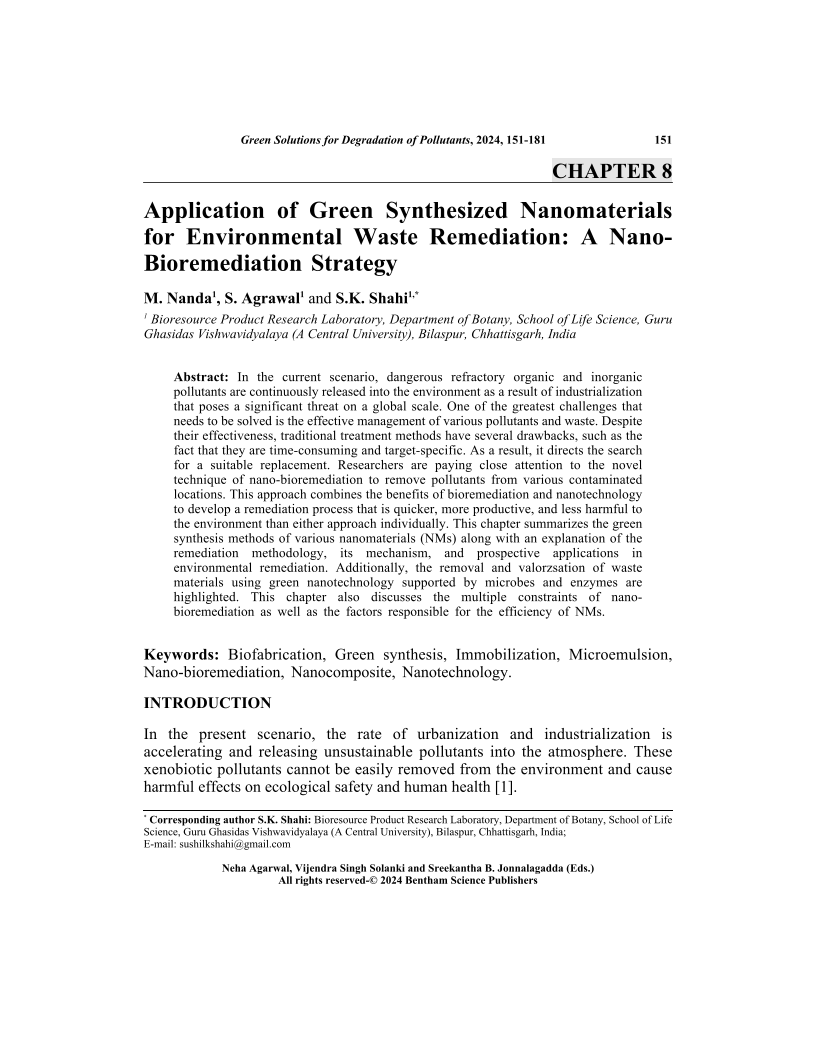Application of Green Synthesized Nanomaterials for Environmental Waste Remediation: A Nano-Bioremediation Strategy

- Authors: M. Nanda1, S. Agrawal2, S. K. Shahi3
-
View Affiliations Hide AffiliationsAffiliations: 1 Bioresource Product Research Laboratory, Department of Botany, School of Life Science, Guru Ghasidas Vishwavidyalaya (A Central University), Bilaspur, Chhattisgarh, India 2 Bioresource Product Research Laboratory, Department of Botany, School of Life Science, Guru Ghasidas Vishwavidyalaya (A Central University), Bilaspur, Chhattisgarh, India 3 Bioresource Product Research Laboratory, Department of Botany, School of Life Science, Guru Ghasidas Vishwavidyalaya (A Central University), Bilaspur, Chhattisgarh, India
- Source: Green Solutions for Degradation of Pollutants , pp 151-181
- Publication Date: August 2024
- Language: English
Application of Green Synthesized Nanomaterials for Environmental Waste Remediation: A Nano-Bioremediation Strategy, Page 1 of 1
< Previous page | Next page > /docserver/preview/fulltext/9789815238969/chapter-8-1.gif
In the current scenario, dangerous refractory organic and inorganic pollutants are continuously released into the environment as a result of industrialization that poses a significant threat on a global scale. One of the greatest challenges that needs to be solved is the effective management of various pollutants and waste. Despite their effectiveness, traditional treatment methods have several drawbacks, such as the fact that they are time-consuming and target-specific. As a result, it directs the search for a suitable replacement. Researchers are paying close attention to the novel technique of nano-bioremediation to remove pollutants from various contaminated locations. This approach combines the benefits of bioremediation and nanotechnology to develop a remediation process that is quicker, more productive, and less harmful to the environment than either approach individually. This chapter summarizes the green synthesis methods of various nanomaterials (NMs) along with an explanation of the remediation methodology, its mechanism, and prospective applications in environmental remediation. Additionally, the removal and valorzsation of waste materials using green nanotechnology supported by microbes and enzymes are highlighted. This chapter also discusses the multiple constraints of nanobioremediation as well as the factors responsible for the efficiency of NMs.
-
From This Site
/content/books/9789815238969.chapter-8dcterms_subject,pub_keyword-contentType:Journal105

